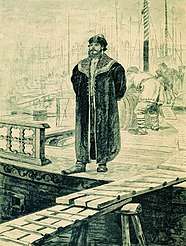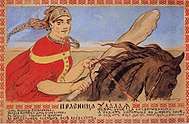Bogatyr

A Bogatyr (Russian: богатырь, IPA: [bəɡɐˈtɨrʲ] (![]()
Etymology

The word bogatyr is not originally Russian. There have been different theories[4] about the origin of the word but researchers agree that bogatyr is not of Slavic origin[5]. Many researchers suspect[5] the word bogatyr is derived from a Mongolian word: baatar, bagadur, baghtur, bator, batyr, and batur, all with meanings along the lines of hero, warrior, and brave. This reasoning originates from noted interactions between Mongols and Rus-Kievan people in the form war and battle, the chance of one influencing the other and vice versa being high. The word bogatyr is used similarly in other modern languages such as Polish (bohater), Hungarian (bator) and Persian (bahadur), meaning hero and/or athlete.
The first time bogatyr is used to denote "hero" and subsequently becoming synonymous with each other was recorded in Stanisław Sarnicki's book Descriptio veteris et novae Poloniae cum divisione ejusdem veteri et nova (A description of the Old and the New Poland with the old, and a new division of the same), printed in 1585 in Cracow (in the Aleksy Rodecki's printing house), in which he says, "Rossi… de heroibus suis, quos Bohatiros id est semideos vocant, aliis persuadere conantur."[4] ("Russians... try to convince others about their heroes whom they call Bogatirs, meaning demigods.")
Overview

Many Rus epic poems, called Bylinas, prominently featured stories about these heroes, as did several chronicles, including the 13th century Galician–Volhynian Chronicle. Some bogatyrs are presumed to be historical figures, while others, like the giant Svyatogor, are purely fictional and possibly descend from Slavic pagan mythology. The epic poems are usually divided into three collections: the Mythological epics, older stories that were told before Kiev-Rus was founded and Christianity was brought to the region, and included magic and the supernatural; the Kievan cycle, that contains the largest number of bogatyrs and their stories(IIya Muromets, Dobrynya Nikitich, and Aloysha Popovich); and the Novgorod cycle, focused on Cadko and Vasily Buslayev, that depicts everyday life in Novgorod[6].

Many of the stories about bogatyrs revolve around the court of Vladimir I of Kiev (958–1015) and are called the Kievan Cycle. The most notable bogatyrs or vityazes served at his court: the trio of Alyosha Popovich, Dobrynya Nikitich and Ilya Muromets. Each of them tends to be known for a certain character trait: Alyosha Popovich for his wits, Dobrynya Nikitich for his courage, and Ilya Muromets for his physical and spiritual power and integrity, and for his dedication to the protection of his homeland and people. Most of those bogatyrs adventures are fictional, and often included fighting dragons, giants and other mythical creatures. However, the bogatyrs themselves were often based on real people. Historical prototypes of both Dobrynya Nikitich (the warlord Dobrynya) and Ilya Muromets are proven to have existed.
The Novgorod Republic produced a specific kind of hero, an adventurer rather than a noble warrior. The most prominent examples were Sadko and Vasily Buslayev who became part of the Novgorod Cycle of folk epics[6].
Mythological epics rooted in the supernatural and shamanism, and related to paganism[6]. The most prominent heroes in these epics are Syvatogor and Volkh Vseslavyevich; they are commonly called the "Elder Bogatyrs".
Later notable bogatyrs also include those who fought by Alexander Nevsky's side, including Vasily Buslayev and those who fought in the Battle of Kulikovo.
Bogatyrs and their heroic tales have influenced many figures in Russian Literature and Art, such Alexander Pushkin, who wrote the 1820 epic fairy tale poem Ruslan and Ludmila, Victor Vasnetsov, and Andrei Ryabushkin whose artworks depict many bogatyrs from the different cycles of folk epics. Bogatyrs are also mentioned in wonder tales in a more playful light as in Foma Berennikov[7], a story in Aleksandr Afanas'ev's collection of tales called Russian Fairy Tales featuring Alyosha Popovich and Ilya Muromets.
Female Bogatyr

Though not as heavily researched, the female bogatyr or polianitsa (Поленица) is a female warrior akin to the Amazons. Many of the more well known polianitsas are wives to the famous male bogatyrs, such as Nastas'ya Nikulichna[8], the wife of Dobrynya Nikitich. The female bogatyr matches the men in strength and bravery with stories detailing instances where they save their husbands and outwit the enemy[8]. They are often seen working with the heroes in tales that mention their presence.

Famous bogatyrs
Most bogatyrs are fictional, but are believed to be based on historical prototypes:
- Ilya Muromets, regarded as the greatest of the bogatyrs, from Murom
- Dobrynya Nikitich – from Ryazan (based on a historical warlord of Vladimir I)
- Alyosha Popovich – from Rostov, a trickster among bogatyrs who is best known for his wits.
- Svyatogor, a giant knight who bequeathed his strength to Ilya Muromets (purely fictional)
- Vasily Buslayev of Novgorod
- Anika the Warrior
- Duke Stepanovich
- Dunaj Ivanovich
- Volga Svyatoslavovich (possibly based on Oleg of Novgorod or Vseslav of Polotsk[9])
- Sukhman The Bogatyr
- Nikita the Furrier
- Mikula Selyaninovich ("Mikula the Villager's Son")
Some of the historical warriors also entered folklore and became known as bogatyrs:
- Gavrila Alexich of Novgorod, who served Alexander Nevsky in Battle of Neva (historical)
- Ratmir of Novgorod, who served Alexander Nevsky in Battle of Neva (historical)
- Peresvet, who sacrificed himself against the Tatars at the Battle of Kulikovo (historical)
Bogatyrs in films
- Films by Alexander Ptushko:
- Sadko (Садко, 1952)
- Ilya Muromets (Илья Муромец, 1956)
- Ruslan and Ludmila (Руслан и Людмила, 1972), based on a fantasy poem of the same name by Alexander Pushkin.
- Soyuzmultfilm animated films (directed by Ivan Aksenchuk):
- Ilya Muromets (1975)
- Ilya Muromets and Nightingale the Robber (1978)
.jpg) Victor Vasnetsov. Dobrynya Nikitich and the Dragon, 1913-1918.
Victor Vasnetsov. Dobrynya Nikitich and the Dragon, 1913-1918.
- Melnitsa Animation series The Three Bogatyrs:
- Alyosha Popovich and Tugarin the Serpent (Алёша Попович и Тугарин Змей, 2004)
- Dobrynya Nikitich and Zmey Gorynych (Добрыня Никитич и Змей Горыныч, 2006)
- Ilya Muromets and Nightingale the Robber (Илья Муромец и Соловей-Разбойник, 2007)
- The Three Bogatyrs and Shamakhan Queen (Три богатыря и Шамаханская царица, 2010)
- The Three Bogatyrs on Distant Shores (Три богатыря на дальних берегах, 2012)
- The Three Bogatyrs: Course of the horse (Три богатыря: Ход конём)
- The Three Bogatyrs and the Sea King (Три богатыря и Морской царь)
- Other films:
- Alexander Nevsky (Александр Невский, 1938) by Sergei Eisenstein. Although based on real history, the film also shows a strong bylina influence and features bylina bogatyr Vasily Buslayev as a secondary character.
- The Battle of Kerzhenets (1971)
- Prince Vladimir (Князь Владимир, 2006) also combines real medieval history with fantasy and folklore.
- Last Knight (2017), a comedy film that deconstructs Russian folklore.
Bogatyrs in books
- Books by Jennifer Estep
- Crimson Frost (2013)
- Midnight Frost (2013)
- Killer Frost (2014)
- Books By Robin Bridges
- The Katerina Trilogy(The Gather Storm(2012), The Unfailing Light(2012), The Morning Star(2013))
See also
- Baghatur
- Bylina, East Slavic epic poetry
- Knight-errant
- Slavic mythology
- Victor Vasnetsov (1848–1926), Russian folk revivalist painter, famous for his depictions of bogatyrs.
- Bogatyr class cruiser, a group of protected cruisers built for the Imperial Russian Navy in 1898–1907, named for its lead ship Bogatyr
- The Bogatyr Gates, a movement from Mussorgsky's piano suite "Pictures at an Exhibition".
References
| Wikimedia Commons has media related to Bogatyr. |
Citations
- 1 2 Bailey, James; Ivanova, Tatyana (1998). An Anthology of Russian Folk Epics. New York: M.E. Sharpe.
- ↑ "Богатыри". www.vehi.net. Retrieved 2018-03-21.
- ↑ Translators, interpreters, and cultural negotiators : mediating and communicating power from the Middle Ages to the Modern Era. Federici, Federico M.,, Tessicini, Dario,. New York, NY. ISBN 9781137400048. OCLC 883902988.
- 1 2 "Богатыри". www.vehi.net. Retrieved 2018-03-21.
- 1 2 Translators, interpreters, and cultural negotiators : mediating and communicating power from the Middle Ages to the Modern Era. Federici, Federico M.,, Tessicini, Dario,. New York, NY. ISBN 9781137400048. OCLC 883902988.
- 1 2 3 Bailey, James; Ivanova, Tatyana (1998). An Anthology of Russian Folk Epics. New York: M.E. Sharpe.
- ↑ 1826-1871., Afanasʹev, A. N. (Aleksandr Nikolaevich),. Russian fairy tales. Guterman, Norbert, 1900-1984., Jakobson, Roman, 1896-1982., Alexeieff, Alexandre, 1901-1982., Rouben Mamoulian Collection (Library of Congress). [New York]. ISBN 0394730909. OCLC 166025.
- 1 2 1958-, Dixon-Kennedy, Mike, (1998). Encyclopedia of Russian & Slavic myth and legend. Santa Barbara, Calif.: ABC-CLIO. ISBN 1576070638. OCLC 39157488.
- ↑ Всеслав Брячиславич // Биографический справочник — Мн.: «Белорусская советская энциклопедия» им. Петруся Бровки, 1982. — Т. 5. — С. 129. — 737 с.
Sources
- Beckwith, Christopher I. (16 March 2009). Empires of the Silk Road: A History of Central Eurasia from the Bronze Age to the Present. Princeton University Press. ISBN 0691135894. Retrieved 30 May 2015.
- Богатыри и витязи Русской земли: По былинам, сказаниям и песням. (1990) Moscow: "Moskovsky Rabochy" publishers (in Russian)
- Ivanova, T. G., and James Bailey. An Anthology of Russian Folk Epics. Braille Jymico Inc., 2006.